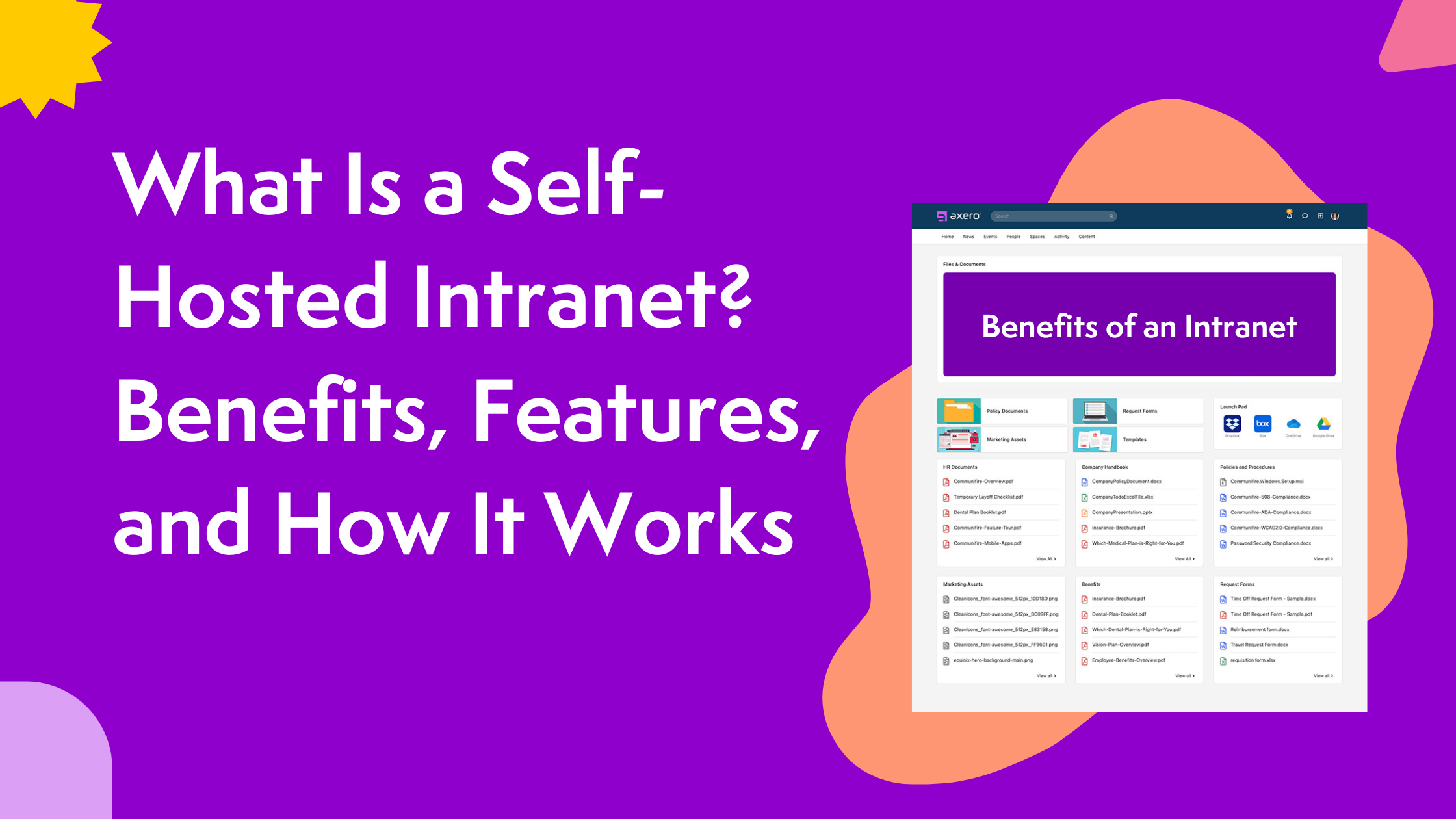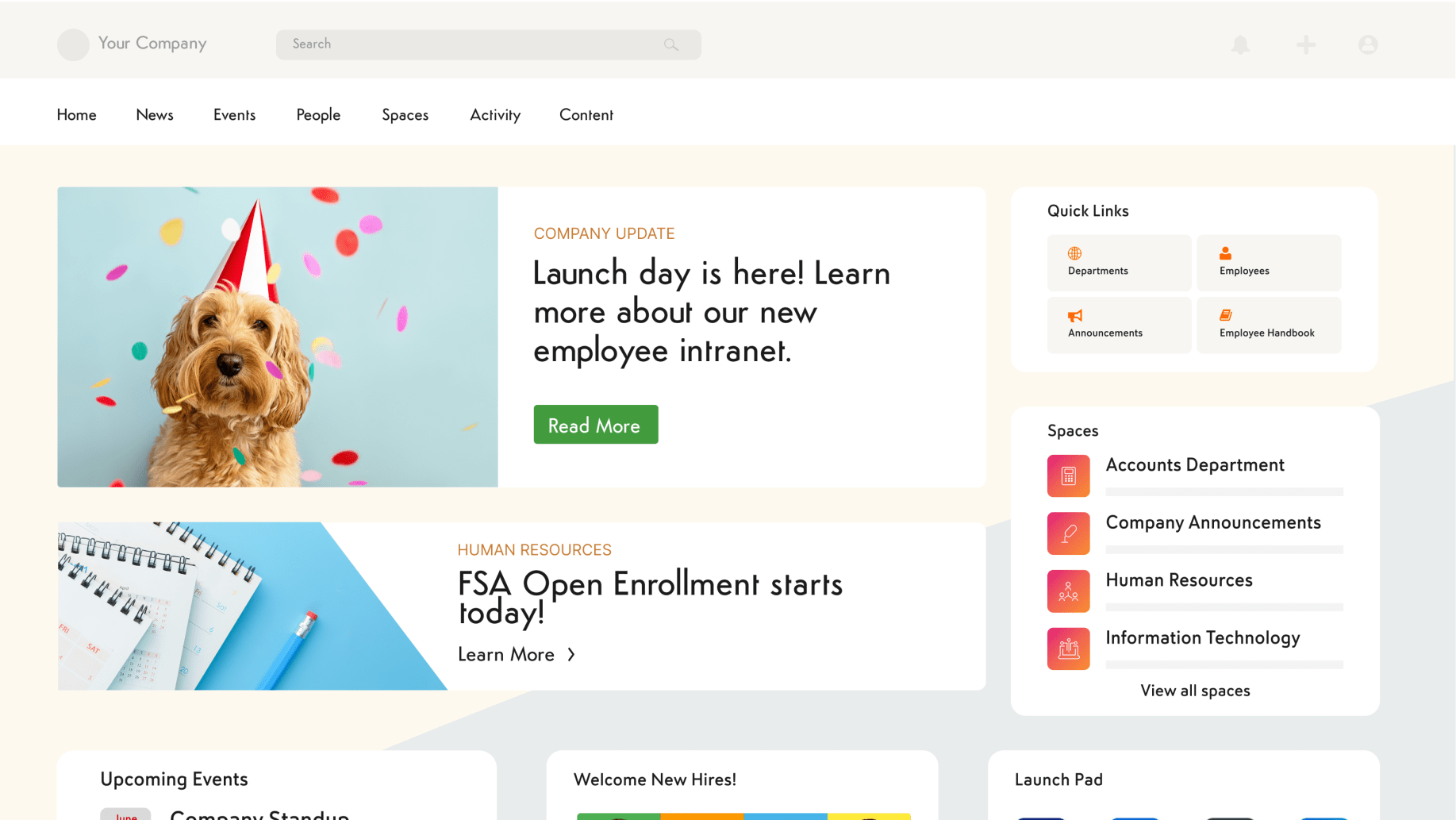One of the major benefits that comes along with using a social intranet is its content management system.
Your intranet may be an excellent vehicle for managing communication and the sharing of ideas between employees, but it’s also a powerful tool for content creation, management, and sharing.
Rather than have to use a variety of applications and programs to create and manage content, everything can be done from the same central location.
As one might expect, intranet content management can become difficult once a fair amount has been amassed. Intranets grow just like businesses, and creating content can in many ways be like feeding a monster — it’s easy for things get out of hand!
Fortunately, there are a number of ways you can manage your intranet content without getting overwhelmed.
As long you stay on top of things, and put general guidelines into place, you and your employees will be able to create and access your intranet content with ease.
What content is useful for the company intranet?
A digital workspace can be enhanced by a well-curated intranet that offers a wealth of useful content. In today’s interconnected business landscape, where remote work and virtual collaboration are increasingly prevalent, having an effective intranet is pivotal.
One of the crucial components of a vibrant intranet is regular and relevant company news. Timely updates on company happenings, achievements, and milestones keep employees informed about the organization’s progress. This fosters a feeling of unity and shared purpose, especially when such news is supplemented with multimedia elements like images and videos.
To ensure effective engagement, the intranet should offer interactive features that encourage participation and collaboration. Discussion forums, comment sections, and survey tools can provide employees with platforms to voice their opinions, ask questions, and provide feedback. Additionally, creating spaces for user-generated content empowers employees to share their expertise and insights, strengthening the sense of community within the organization.
Intranet users also greatly benefit from comprehensive employee profiles and directories. These digital profiles offer a glimpse into the diverse talents, skills, and experiences of colleagues, facilitating smoother collaboration and knowledge sharing.
7 Tips for Managing your Intranet Content Management
1. Understand the Lifecycle of Intranet Content
If there’s one thing that you should focus on before you even begin to tackle an intranet content management system, it’s learning about the lifecycle of content and the collaboration tools used to create it. No matter what type of intranet content you’re creating, there’s a good chance it will follow the same or similar path.
- Creation comes first, which includes the planning, writing and approval process that most people are familiar with.
- Next, your content is published, a process that includes managing versions, adding meta data, updating it to make it more comprehensive, and optimization.
- Finally comes management, during which you’ll review content, promote it, and archive or delete information that is no longer relevant.
Understanding the lifecycle of intranet content can be immensely helpful if you’re planning to flesh out your social intranet. It serves as a constant reminder that the job isn’t done once content has been published — proper management comes next.
Whether that means updating, deleting or archiving the content in question will depend on the situation, and these are just a few examples of directions you can take.
2. Create a Strategy and General Guidelines for Intranet Content Creation
Intranet content creation should be viewed as a campaign in its own right. If you don’t have an effective strategy laid out prior to getting started, chances are you’re going to run into issues sooner than later. Creating an intranet content strategy can be as simple or as difficult as you make it, but it’s essential to running a streamlined intranet.
Your strategy should revolve around specific goals that you have in mind for intranet content creation. Some organizations use their social intranets specifically for employee collaboration, to reduce email volume, and cut back on the time it takes to retrieve and access information.
Others create content with external goals in mind — to provide self-service support, for marketing purposes, and increasing ROI, for example. The strategy that you lay out for your content campaign will depend entirely upon what you’re trying to achieve with it.
As with any strategy, it’s important to keep your goals and objectives realistic. Trying to achieve the impossible will do nothing but cause headaches for you and your employees, and you’ll end up losing value time and energy to the process. Set your expectations high, but never so high that you’ll most likely end up letting yourself down.
3. Enlist Community Managers
You could spend hours each day trying to manage your intranet content, but you’re still going to end up behind the ball if you don’t enlist community managers to give you a hand.
Intranet content management is a full-time job and should be done by everyone. This being said, you can spread out basic content management tasks among a variety of different employees to achieve the same end result, which is where community managers come in.
They should have a working knowledge of how to manage content using social intranet software in a swift and efficient manner, as this will be a huge part of their role. Choose carefully when picking a group of employees to manage content creation within your social community.
4. Communicate Often
More often than not, poor intranet content management results from a lack of internal communication between employees, community managers and the higher-ups.
Communication is the cornerstone of any social intranet, and it applies just as heavily to content creation as it does anything else.
Communicating about the current state of your intranet content on a regular basis is one of the best ways to ensure that nothing is going overlooked. You might choose to meet as a group in the office if possible, or perhaps communicate through your intranet’s discussion platform.
Either way, checking in with those who are creating and managing your intranet content on a regular basis can make all the difference in the world.
5. Train Employees on Content Creation
Creating content via intranet software is exceptionally easy, but only when one knows what they’re doing. While intuitive social intranets can be confusing at first for those who aren’t familiar with them, a quick training session can save you a great deal of future frustration.
Ideally, your community content managers should learn the process of creating content in your social intranet inside and out. Once they have a working knowledge in place, they can schedule individual or group training sessions with those who will be using the intranet to create content.
Going over the basics and answering any questions employees may have will help to boost confidence and awareness within the intranet, empowering all who create, publish and manage content.
While training sessions are best carried out in a physical office, you can train remote employees from right within the software itself, via telephone, web conferencing, and screen sharing.
6. Learn to Tag Content
Social intranet software is unique in that it allows the user to tag content that has been created. In the end, this becomes a highly functional method of organizing materials within your intranet.
If you write a post about cloud-based telephone services, for example, you can tag it with words such as “communication” or “tech” or “cloud” or “telephone.”
These categories become vital to retrieving and accessing information in the future and should never be overlooked.
If there’s one problem associated with tagging intranet content, it’s that users forget to do it. It’s easy to spend time working on a page and be so pleased when you’re finished that you forget to take that last step. Whatever you can do to remind yourself, your community managers, and others who are creating content on your intranet to tag each piece they complete. You can even lend a hand to other peoples content and update it with tags when you see fit.
7. Evaluate What’s Working and What Isn’t
Once the wheel of content creation in your social intranet has been spinning for a while, you’ll have the chance to review what’s working and what isn’t. This encompasses much of the process of creating, publishing and managing content, from internal processes to how external content performs on the web.
Reviewing your progress is the only way to ensure that your intranet is growing in the right direction, especially if your organization has implemented it fairly recently.
After you’ve taken a look at the current status of your intranet content, you can take a number of different directions. Content that hasn’t performed well either internally or externally may be archived or deleted, or you may find that a particular blogging strategy has been effective and choose to replicate it into the future.
At the very least, you’ll gain a better view of the health of your intranet and will have the opportunity to make any necessary changes to continue its growth.
In Conclusion
Content creation is a key aspect of any social intranet, which is why it’s important to ensure that you’re not letting things get away from you.
Take the above tips to heart, and you’ll have nothing to worry about.












 info@axerosolutions.com
info@axerosolutions.com 1-855-AXERO-55
1-855-AXERO-55


